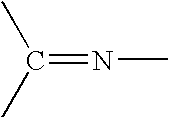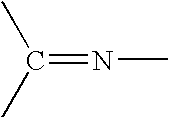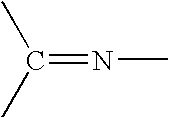Process for the hydrogenation of imines
a technology of imines and hydrogenation processes, applied in the preparation of amino compounds, organic chemistry, carboxylic acid amides, etc., can solve the problems of economic viability, low catalyst productivity, and inability to achieve complete conversion
- Summary
- Abstract
- Description
- Claims
- Application Information
AI Technical Summary
Benefits of technology
Problems solved by technology
Method used
Image
Examples
example 1
[0122] The following example illustrates the synthesis of some of the phosphonium halides (see Beller et al. in Synthesis 2004, 934-941)
[0123] Synthesis of Diadamanthyl benzyl phosphonium bromide
[0124] Diadamanthyl phosphine (10 mmol, 3.02 g) were suspended in the air in 6 ml benzylbromide and 40 ml dibutylether. The reaction mixture was stirred at 138° C. for 16 h. After cooling down, the solids were filtrated, washed with MTBE and dried. Yield: 4.05 g, 86% (white powder)
example 2
[0125] Hydrogenation of 2,4,6-Trimethyl-N-(4-methylpentan-2-ylidene)aniline using different phosphonium halides and ligands (for comparison effects some experiments using Bu4NI are also given):
[0126] The desired additive (0.004-0.006 mmol) was weighted in a 1.5ml GC-flask under argon (Glovebox). Then, 300 μl of toluene was added. Subsequently, 50 μl of a 0.01M solution of [Ir(1,5-cyclooctadiene)Cl]2 in toluene (0.0005 mmol) and 50 μl of a 0.02M solution of a ligand in toluene (0.001 mmol) were added. The mixture was stirred for 15 minutes at room temperature. Then, 250 μl of neat substrate or 200 μl of a 2 M or 1M solution of substrate in toluene were added. The flask was closed with a septum which was pierced several times with a needle and placed in an aluminium microtiterplate and introduced in an autoclave. The autoclave was purged with hydrogen and 55 bar hydrogen were introduced. The temperature was set to 65° C. and the stirring was started for 1.75 h. The pressure was relea...
example 3
[0127] The following examples were done in a similar way as Example 2 but changing the ligand, solvent, the reaction time, reaction temperature and / or the phosphonium halide:
ReactiontimeTPConversioneeLigandS / CHalide(h)(° C.)(bar)Solvent(%)(%)R,R-Chiraphos200none1.756555Toluene00R,R-Chiraphos200Bu4NI1.756555Toluene00R,R-Chiraphos200cataCXium A-HI1.756555Toluene420Xyliphos200none1.756555Toluene6237Xyliphos200cataCXium A-HI1.756555Toluene10039Xyliphos200Ph3P(iPr)I1.756555Toluene7039Xyliphos200cataCXium ABn-HBr1.756555Toluene10043Xyliphos200Ph3PMeBr3.56555Toluene9038S,Ra-Bophoz200none1.756555Toluene2316S,Ra-Bophoz200Ph3P(iPr)I1.756555Toluene3515S,Ra-Bophoz200cataCXium ABn-HBr1.756555Toluene600S,Ra-Bophoz200Ph3PMeBr3.56555Toluene6010catASium T3200none1.756555Toluene00catASium T3200cataCXium ABn-HBr1.756555Toluene1928catASium MNAn200Ph3PMeBr3.56555Toluene58(S)-(f)-Binaphane200Ph3PMeBr3.56555Toluene7519Xyliphos2000none4.55064CH2Cl200Xyliphos2000cataCXium A-HI4.55064CH2Cl23938Xyliphos2000...
PUM
| Property | Measurement | Unit |
|---|---|---|
| reaction temperature | aaaaa | aaaaa |
| hydrogen pressure | aaaaa | aaaaa |
| temperatures | aaaaa | aaaaa |
Abstract
Description
Claims
Application Information
 Login to View More
Login to View More - R&D
- Intellectual Property
- Life Sciences
- Materials
- Tech Scout
- Unparalleled Data Quality
- Higher Quality Content
- 60% Fewer Hallucinations
Browse by: Latest US Patents, China's latest patents, Technical Efficacy Thesaurus, Application Domain, Technology Topic, Popular Technical Reports.
© 2025 PatSnap. All rights reserved.Legal|Privacy policy|Modern Slavery Act Transparency Statement|Sitemap|About US| Contact US: help@patsnap.com



